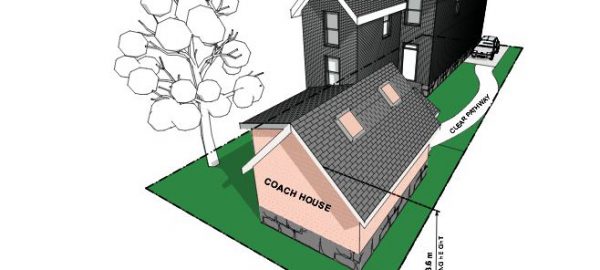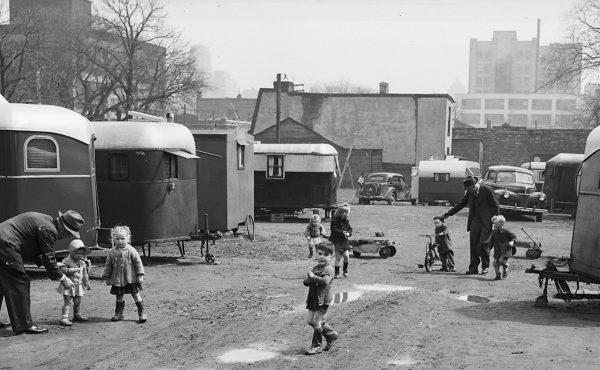Last week saw another of the regular surges of interest in laneway houses in Toronto. But we should also look to backyards without lanes, often in suburban lots, when thinking about this kind of housing. You don’t need a laneway to build a small house behind a house.
One can see why laneway houses inspire such interest. Built in spaces intended for garages, they have an urban, slightly gritty-in-a-cool-way image, and help fill a need in the most in-demand, walkable and transit-friendly housing neighbourhoods in the older parts of Toronto. As well, in the past they have often been individually designed by and for architects, which adds to their cool factor.
The current surge of interest was prompted by a new report from a group called Lanescape that urges the city to adjust its zoning to enable laneway housing. To its credit, the group gets away from the past model of laneway houses as individual detached houses, which were expensive and time-consuming due to the need to sever properties, provide separate services, and zone, design and build individually. Instead, it presents them as being secondary suites, like a basement apartment, sharing access and services with the main buildings. As well as being simpler (and hopefully cheaper) to process, this helps to address the need for expanded rental units in the old city — an issue that was previously swamped by the fuss over the increasing price of ownership, but is now starting to get attention.
The report prompted articles in NOW magazine, the Globe and Mail (by my Spacing colleague John Lorinc) and elsewhere, and coincided with an announcement by the University of Toronto that it plans to build laneway housing in parts of its downtown campus.
Laneway housing has potential, but it also has limitations. Laneways are only present in certain neighbourhoods, mostly restricted to the older parts of the city. So not only is there a limited supply, but their benefits are only available in one geographic area.
But behind-the-house housing (the term “coach house” can be used to describe all forms of this type of housing) can also be built in reasonably spacious back yards where there is no laneway. Bringing backyard housing into the conversation enables us to open up this option to a much wider range of Toronto housing and Toronto neighbourhoods, including suburban neighbourhoods.
Backyard houses are entirely feasible. The City of Ottawa has recently approved detailed regulations for building backyard houses (PDF). Like the Lanescape proposal, Ottawa’s backyard houses are treated like a secondary suite, thus a rental unit that shares services with the main house. Only a standard walkway to the backyard is required. The guidelines set limitations on size and height to protect the privacy of neighbours.
Backyard housing has been tried successfully elsewhere. Since renting them out was legalized in 2009 in New South Wales, Australia, the number being built each year has reached around 5,000 units.
For last year’s “Housing” issue of Spacing, I talked to Sa’ad Ahmed, founder of Tiny Toronto, which is dedicated to making it possible for homeowners to build small coach houses in their backyards. He pointed out that just over half of Scarborough households live in a house on a detached lot, as do a significant number of households in other suburbs, many of which have backyards deep enough for a coach house.
The value of enabling such building in the suburbs goes beyond simply increasing the number of rental units in the city. Toronto’s old city is in high demand because more people are looking to live in dense, walkable neighbourhoods with nearby shopping, amenities and transit on old-fashioned main streets. But the supply of such neighbourhoods is largely limited to the pre-1950 city, and the limited supply is causing prices to skyrocket.
Through the Official Plan’s “Avenues” strategy, the City of Toronto is trying to extend that in-demand main street functionality, which supports improved transit and more amenities within walking distance, into the inner suburbs. But to get enough people in the area to achieve this goal, it won’t be enough to just build higher buildings along the avenue. The surrounding suburban housing areas also need to increase in density to support local retail and transit, just as the densely packed houses of the old city help to support streetcar lines and main street retail. As well, because they are new builds, units in “Avenue” buildings will likely be fairly expensive to buy or rent — it would be desirable to also have more affordable rental options nearby.
The Official Plan designates these surrounding housing neighbourhoods as “stable”, but it’s useful to remember that even while remaining house-based, Toronto’s house neighbourhoods have never been perfectly stable. Cheap, slum-like houses were rebuilt into bigger, solid ones. Small houses were expanded with additions. Cottages along the lake were rebuilt as permanent housing. Mansions became subdivided into multiple apartments. Plenty of change and intensification is possible while maintaining a house-based urban form. As Ahmed says, backyard houses “can be a way of creating density in the suburbs without disrupting them.”
Other elements of suburban housing intensification could include, for example, allowing suburban lots to be rebuilt with semi-detached or duplex housing on them. But an advantage of coach houses is that they provide rental, not ownership, housing, opening them up to a wider range of people. As well, since they’re built by the property owner, there’s no land cost involved, and the buildings are modest, so they can be built less expensively and therefore provide relatively affordable accommodation. They also provide greater flexibility in housing arrangements, for example as a close but separate residence for elderly relatives (they are called “granny flats” in Australia) or for young adult children getting themselves established in the workforce.
An important element of Ottawa’s rules, which makes them much simpler to implement, is that backyard houses do not require new parking. There is plenty of parking surface already available in large suburban driveways and at the side of suburban streets. As well, Toronto has a comprehensive transit network, and it would be beneficial to the city if people living in backyard houses walked, cycled and used transit to get where they need to go.
There are probably more lots in Toronto that could implement backyard housing than laneway housing, and it would extend the benefits of these kinds of secondary suites to a much wider area of the city. We need to make sure we include backyard housing as well whenever we discuss laneway housing.
Image from the City of Ottawa
Addendum: unknown to me, at the same time as I wrote this post, planning student Kelsey Carriere was presenting a thesis about Backyard Housing for her M.Sc. degree in Planning at the University of Toronto. It includes a great deal of detail about other cities’ policies and what could be done in Toronto. Her rough estimate “suggests that there are 175,801 properties in the City of Toronto, or 34% of all single family residential lots, eligible to build garden suites, nearly 30 times the [estimated] 6,150 potential laneway suites.” Read her full report (PDF).






One comment
Excellent piece with one correction:
[they are called “granny flats” in Australia]
And in many other nations, many advanced ones with a higher standard of living than here. It’s a concept long overdue for Toronto.